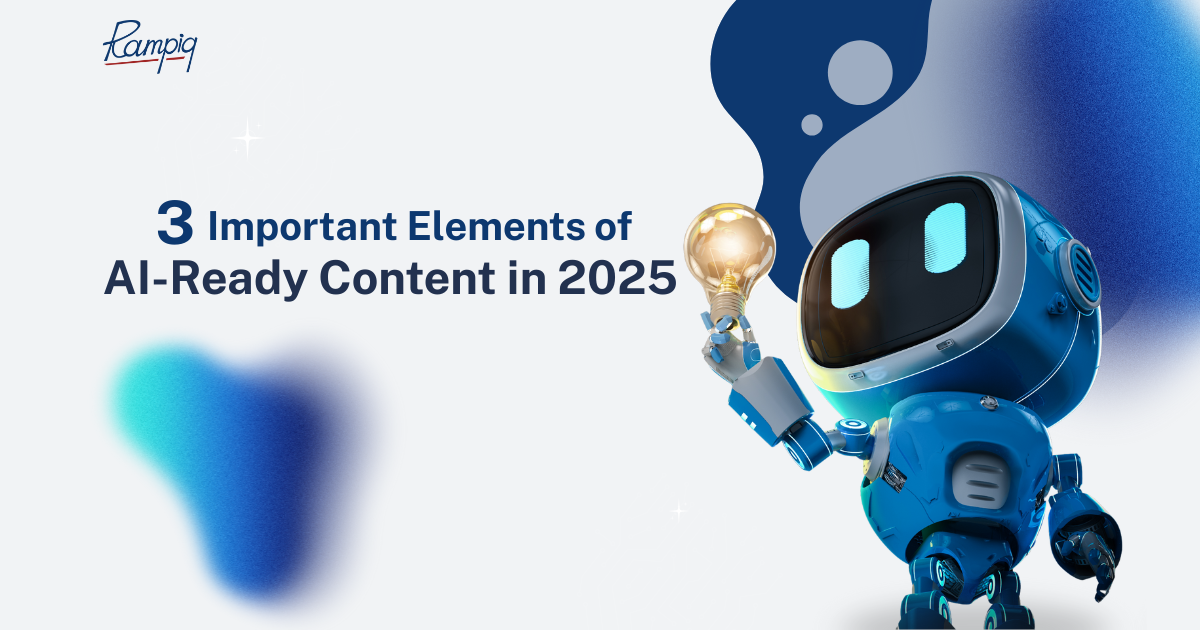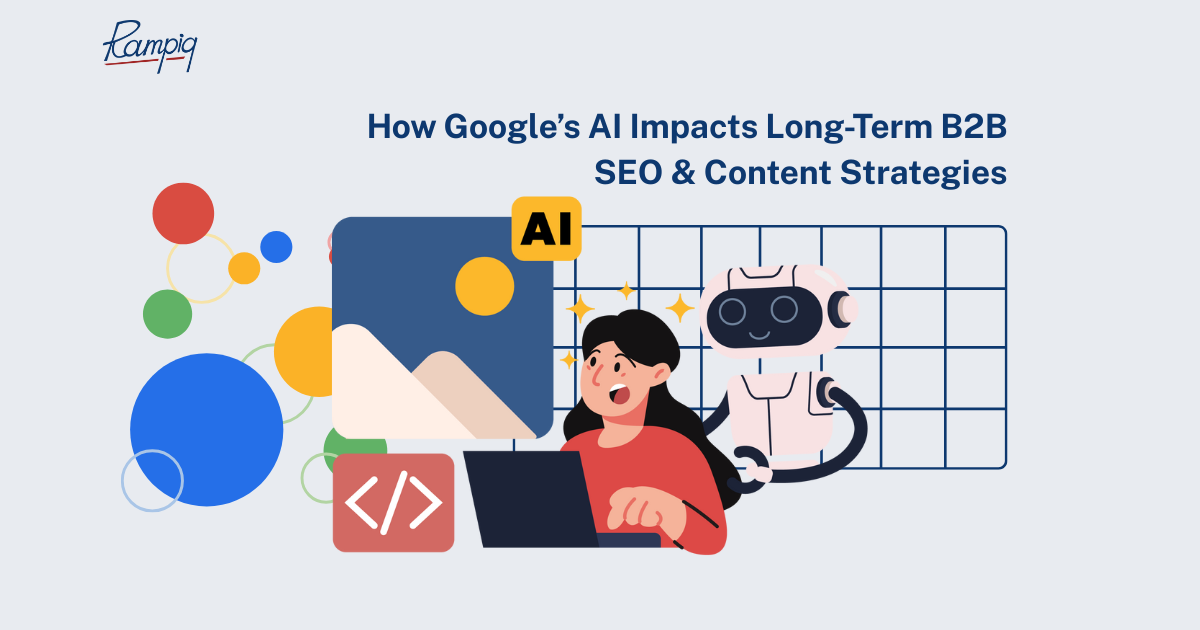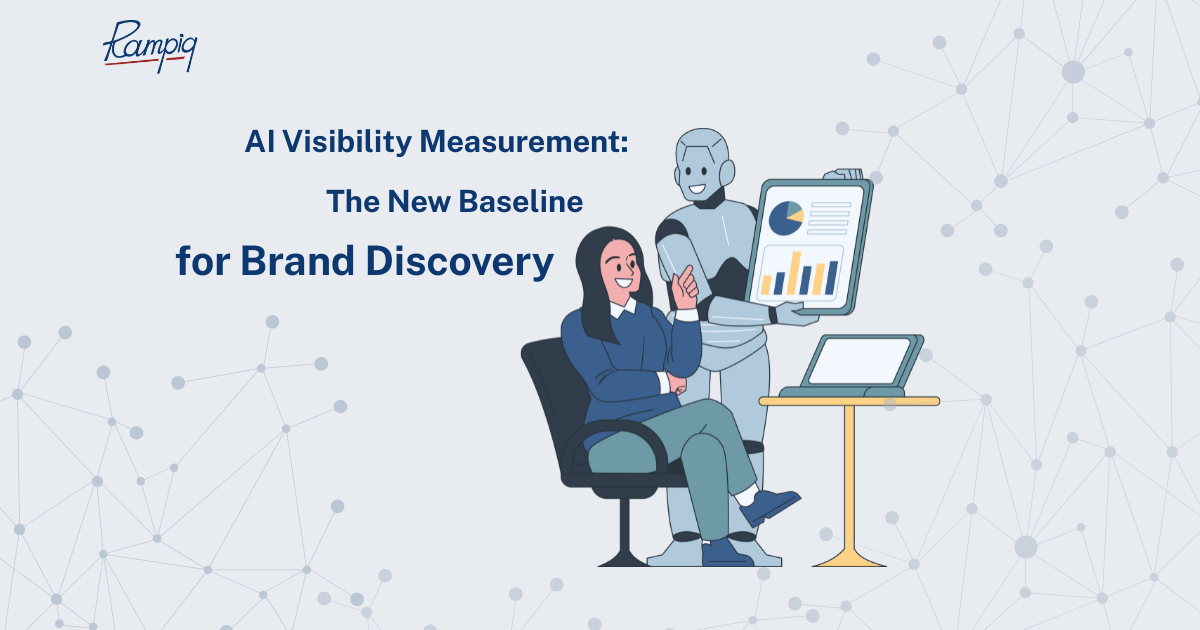Understanding E-EAT and Its Impact on Your Business’s Success
In a world where content creation can be now automated at scale, E-EAT stands to protect real experts and creators from being outranked by AI-written articles and other forms of low-quality content.
E-E-A-T is Google’s framework for evaluating the quality and credibility of web content.
Few B2B business owners and marketers know, however, that strong E-E-A-T signals can boost their website’s credibility, improve search rankings and traffic, and ultimately enhance their online success.
However, the more significant the information on the web page is to the consumer’s well-being, the higher the Google E-E-A-T bar is set. This is why YMYL (Your Money or Your Life) topics are the most affected. In B2B niches, the more customer money is at stake, the stronger E-EAT factors your website needs to have to rank and drive revenue. We will discuss YMYL later, but for now, let’s dissect Google’s E-E-A-T.
E – Experience
Signals for the first “E” – Experience indicates that the author is not simply rewriting information from other sources, but that they are speaking from their practical knowledge. Since December 2022, product reviews now need original videos and images of the reviewer using the product. In B2B space, service businesses now need references to case studies and real customer feedback..
Not only does evaluating experience help demonstrate E-E-A-T, but it also builds your users’ confidence in your information, service, or product. This is crucial for Google’s ultimate goal, which is to present the most valuable results highest in the search results.
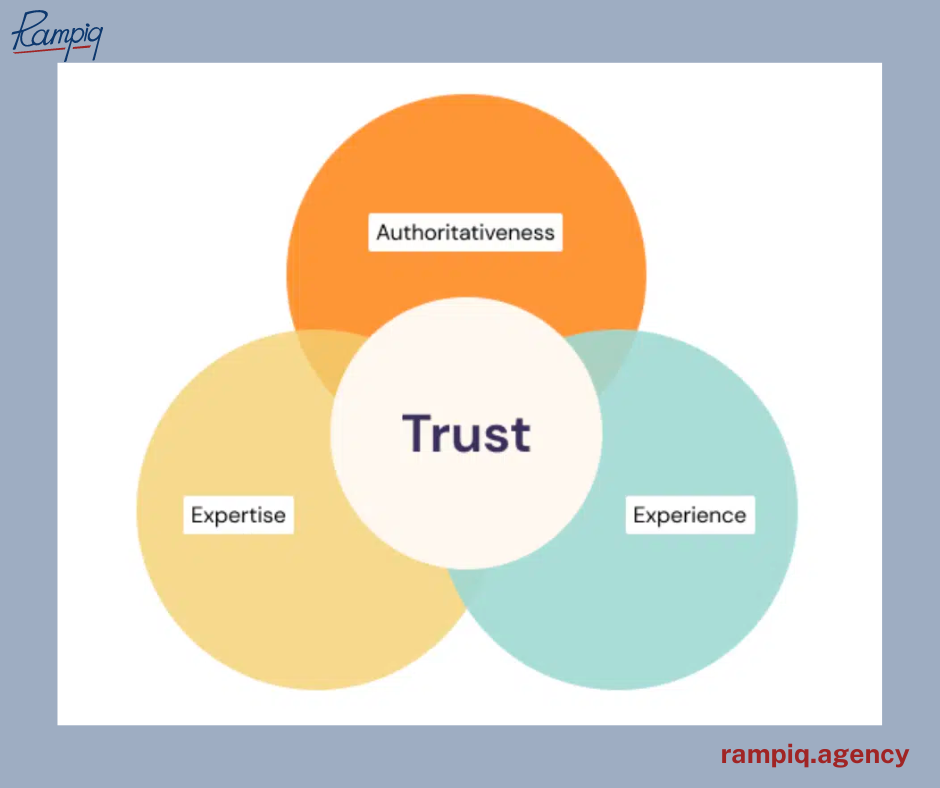
E – Expertise
Expertise goes hand-in-hand with experience and means the depth and breadth of knowledge in the field. Google wants authors and websites as a whole to showcase their understanding of the subject matter.
Hence, Google looks out for evidence such as educational qualifications, certifications, contributions to reputable publications, and so on for the content authors and business as a whole. The goal of assessing expertise is to reward websites that are reliable sources of information in their fields.
A – Authoritativeness
The more Google perceives you as an authoritative figure in your industry, the higher your chances of ranking better in the SERPs. Google looks at industry recognition, citations from other reputable websites (backlinks), and overall online presence.
For this element as well, Google focuses on both individual authors and the overall website. Authoritativeness goes together with the final element, which is Trustworthiness.
T – Trustworthiness
Trustworthiness is essentially a result of demonstrating experience, expertise, and authoritativeness in a subject or niche. This E-E-A-T signal is all about your audience’s perception of your website. Since people tend to trust cleanly built websites that provide accurate, reliable, and transparent information, these are the sort of factors Google evaluates also.
Having clear data protection and privacy policies, secure payment, and positive user reviews; engaging with your audience, addressing their concerns, and delivering consistent high-quality content to establish trustworthiness is more important than ever as they now directly impact websites’ visibility in search results.
In the sections that follow, we’ll show you how to demonstrate each E-E-A-T signal to Google to reap the benefits of this concept in the B2B niche.
Proving Experience: Showcasing Your Business’s Track Record
Highlighting your business’ firsthand or real-life experiences relevant to the topics you cover is a powerful way to demonstrate your expertise. Unlike AI, which cannot provide genuine personal experiences, your business can leverage its unique insights and real-world knowledge.
You can do this by sharing success stories, case studies, and testimonials. These establish your solid track record and sets you apart from less-experienced competitors in the eyes of your audience. For Google, it provides a strong signal for E-E-A-T which is especially crucial for sensitive topics, such as YMYL pages.
Demonstrating Expertise: Proving Subject Matter Knowledge
Positioning your business as a Subject Matter Expert (SME) in your niche is essential for reinforcing Google E-E-A-T. In your content, you have to emphasize your education, professional certifications, team members’ industry recognitions, associations’ memberships, and any other relevant details that give your audience confidence in your opinions. You’re telling your audience why they should listen to you and essentially making a case to Google as to why your content deserves to rank high for the topics you cover.
AI cannot replicate proof of your expertise and neither can competitors who simply do not have your qualifications. Hence, you have to ensure that every piece of content you put out showcases the depth of knowledge and skills that your business brings to the table.
Establishing Authoritativeness: Becoming a Trusted Source
Cultivating your reputation as a go-to source in your industry is a vital step in demonstrating E-E-A-T. To do this, you must produce comprehensive, detailed, and valuable content that dives deeper than what less experienced sources or AI-generated content can.
If you are experienced and have expertise, then you’re pretty much one more step from being known as an authority. On your pages, you now have to provide in-depth analyses, research-backed insights, and practical solutions to your audience’s pain points. Doing all these will help establish your authority and build trust with your audience as well as with Google.
A pro tip to build authoritativeness is to cover all aspects of a particular topic. Are you in a broad industry or niche? Then pick apart your main topics and then break them down again into even smaller subtopics. Do that until you can identify a relevant subtopic for which you can publish content of all its aspects important to your business.
You may repeat this process for more subtopics, and while doing that, you will notice that new posts on these topics rank faster and higher than they would if they didn’t have supporting content.
Backlinks from relevant authoritative websites also help boost authoritativeness in Google’s E-E-A-T. Not only do these links pass important PageRank, but coming from the right sources, they position your website as one with content authoritative enough to be referenced from such websites.
Building an online personal brand can significantly help show authoritativeness in the B2B space. Every blog post should have a detailed author’s bio section, if possible, with their most important social links.
Demonstrating Trustworthiness: Gaining Google’s Confidence
Trustworthiness, the final piece of the proverbial puzzle, is a cumulative result of the demonstration of all other E-E-A-T factors. Google evaluates trustworthiness based on how accurate, honest, safe, and reliable your content is. Let’s look into these factors:
- Accuracy: Double-check the facts, statistics, and information before presenting them on your website. Avoid making false claims or spreading misinformation.
- Honesty: Be transparent with your audience about your identity and the information you publish. For instance, do not make bogus claims and clearly disclose any potential conflicts of interest, such as sponsored content. All in all, you want to build a reputation of honesty and integrity.
- Safety: Prioritize user safety by implementing secure browsing protocols, protecting their data, and presenting a safe browsing experience on your site.
- Reliability: Consistently provide reliable and up-to-date information. Review and update your content regularly to reflect industry changes. The goal here is to be a reliable source of information for your audience.
E-E-A-T SEO Checklist
The E-E-A-T factors we have discussed in the previous section apply to three levels – the content, author, and publisher. Here is a checklist to consider when assessing your E-E-A-T on these levels:
Content E-E-A-T
- Is your content accurate, reliable, and up-to-date?
- Does your content showcase expertise and provide valuable insights?
- Is your content comprehensive and detailed, going further than what AI-generated content can offer?
- Do you cite authoritative sources to support your claims and information?
Author E-E-A-T
- Do your team members possess relevant expertise, qualifications, and professional certifications? Did you mention these?
- Have you showcased the credentials and expertise of your authors or content contributors?
- Do you provide author bios and profiles to establish credibility and trust?
Publisher E-E-A-T
- Does your business have a well-established track record and experience in the industry?
- Have you highlighted your business’s success stories, case studies, and testimonials?
- Are you recognized as an authority or trusted source within your industry?
3 Levels of E-E-A-T
We cannot explain demonstrating Google E-E-A-T without noting that there are 4 levels of E-E-A-T. Google explicitly describes the various levels of E-E-A-T implementation in its search quality rater guidelines. Let’s understand these levels according to Google.
Lacking E-E-A-T
Considering that E-E-A-T is assessed on various levels as discussed (author, content, and publisher), a website may demonstrate E-E-A-T on particular subjects but lack on others. A good example is a B2B SaaS agency, Rampiq.
We frequently publish content on B2B marketing and organic growth, and these pages tend to perform well on the SERPs because our authors, content, and website demonstrate E-E-A-T in the industry.
However, if our PPC expert publishes a page about a sporting event on our blog, this piece of content will have a hard time ranking high. Such pages can be said to lack E-E-A-T.
The above example is an instance of a piece of content lacking E-E-A-T. But it can also be seen at different levels. Here are some practical cases of pages that lack E-E-A-T:
- The author does not have real-life experience relevant to the content.
- The content or the entire site lacks elements that build trust.
- The page’s author lacks the expertise needed for their opinions to be trusted.
- The website is not seen as a trusted resource in their industry.
Lowest E-E-A-T
Unlike the pages lacking E-E-A-T, pages with the lowest E-E-A-T demonstrate one or more Google E-E-A-T signals but lack others. For instance, in a case where an experienced software developer publishes a relevant article on an authoritative, trustworthy website. On paper, it would look like E-E-A-T is covered. But this website can contain dangerous ads or lack a good page experience, and thus the Trust factor is missing.
Such pages can be said to demonstrate the lowest level of E-E-A-T. Some signals of pages with the lowest level of E-E-A-T include:
- The page was built with features or an interface that can trick users to take actions that are detrimental to the user but benefit only the organization.
- Unclear or deceptive design, page intent, or purpose.
- The author or publisher lacks solid industry experience or reputation.
- Insufficient information about the business or author.
High Level of E-E-A-T
Websites with a high level of E-E-A-T publish content by authors with adequate E-E-A-T signals. The website itself as well as the content published are also authoritative, trustworthy, and refer to the author’s experience and expertise.
According to Google, it’s straightforward for government or news websites to achieve a high level of E-E-A-T. But every other website can also achieve this by following the guidelines we have discussed in this post.
Very High Level of E-E-A-T
These are the ideal websites. They satisfy every E-E-A-T factor, and the main difference between them and the websites with just a high level of E-E-A-T is consistency.
Not only would these websites have a few posts from highly experienced authors, but the entire website would also be a trove of relevant, trustworthy information. This means that every page demonstrates the required attributes, the website looks clean and user-focused, and overall, there’s no questionable element on the website.
The rules for achieving the highest level of E-E-A-T differ by industry, content type, topic, and intent. For example:
- Informational content must be factual, original to the website, comprehensive, and well-presented. While high-quality informational pages of different types will all share common attributes, they are also evaluated differently depending on their significance to the well-being of the users. For instance, YMYL content will be more rigorously evaluated than a post on fashion tips.
- News content should be original, and the website should be the first or one of the first to break the news. This means that the piece of news would be unknown to the public if the page was not published. Furthermore, to achieve trustworthiness, news posts must be accurate, detailed, and non-biased, and cite information sources.
- Creative content such as pictures, art, videos, or creative text must be unique and authored by experienced and talented content creators or artists. Apart from that, you must also bear in mind that the significance of the creative content determines how Google evaluates the page’s E-E-A-T. That means that scientific videos, for instance, would be more strictly assessed than one that shows lifehacks.
In the section that follows, we will offer useful tips to consider when optimizing your website and content to achieve a very high level of Google E-E-A-T.
Practical SEO Tips for Strengthening Your Business’s E-E-A-T
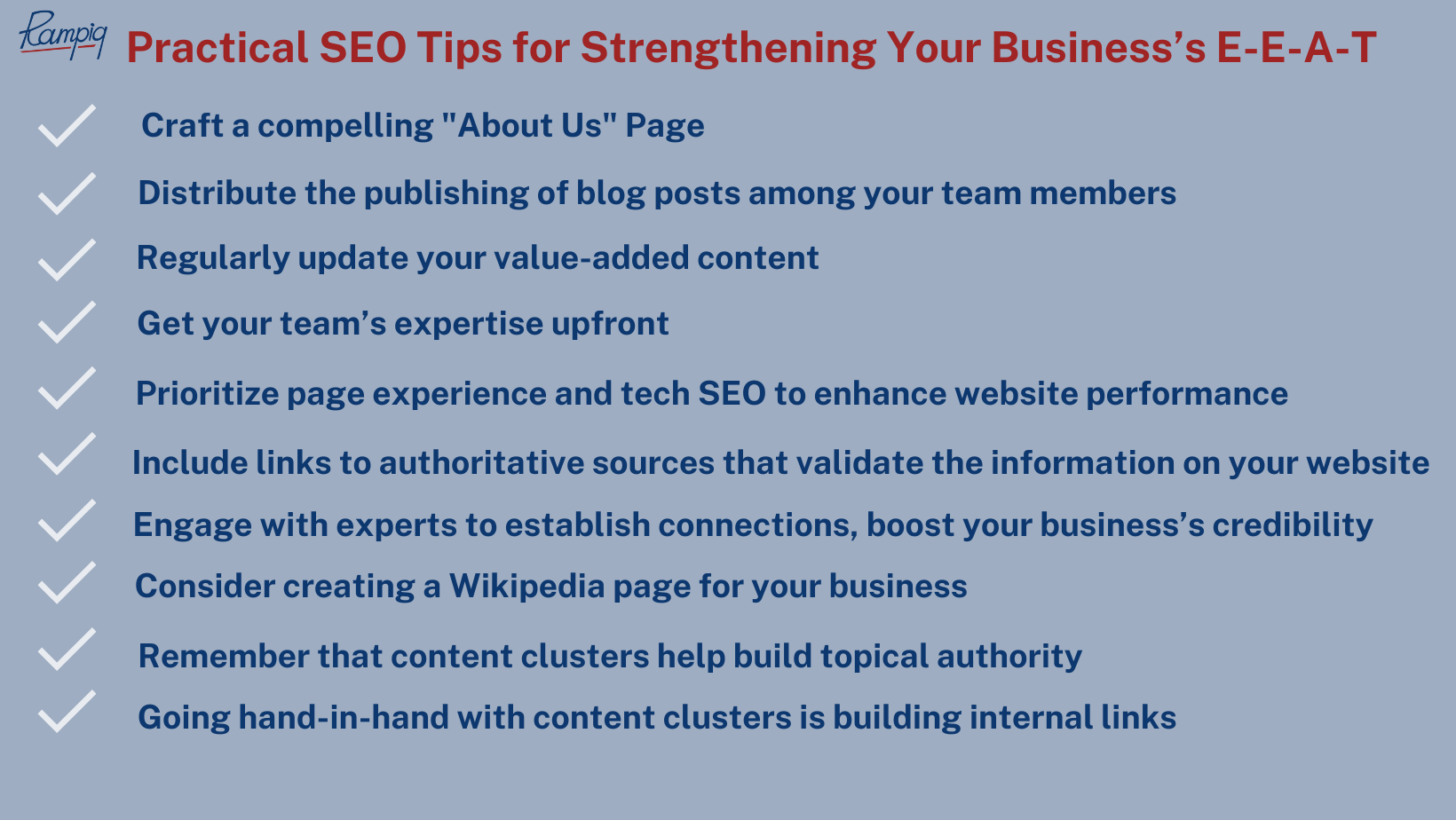
To enhance your business website’s E-E-A-T, here are some tips to consider implementing:
- Craft a compelling “About Us” page that showcases your team’s profiles. Add their photos, bios, professional credentials, and links, for example, to their LinkedIn profiles. See this example for reference.
- Distribute the publishing of blog posts among your team members. This is so that the subject matter experts are contributing to the relevant topics for author E-E-A-T as well as your business’ authority in the industry.
- Regularly update your value-added content to show that you care about reviewing and keeping important information up to date as things change.
- Get your team’s expertise upfront. Interview your team members, and show how talented they are with expert comments and short videos that can complement your content.
- Prioritize page experience and technical SEO to enhance user satisfaction and website performance. Focus on page loading speed, mobile responsiveness, and user-friendly navigation.
- Include links to authoritative sources that support and validate the information presented on your website. This helps to establish credibility and demonstrate that you’re committed to providing reliable information. Additionally, external links to relevant authoritative websites are SEO ranking factors.
- Engage with industry experts, influencers, and thought leaders to establish connections and further boost your business’s credibility. Collaborate with them on content, participate in industry events (for website content material), and leverage their expertise to enhance your E-E-A-T.
- Consider creating a Wikipedia page for your business. While this is not mandatory, having one can contribute to your overall E-E-A-T and provide additional visibility.
- Remember that content clusters help build topical authority – which is a vital Google E-E-A-T factor. You want to become an authoritative voice, so you need a host of content to attest to your knowledge. They also help structure your internal linking to a pillar page that stands a much better chance of ranking high in the SERPs.
- Going hand-in-hand with content clusters is building internal links. Link similar articles together, and ensure that there are no orphan pages on the website.




